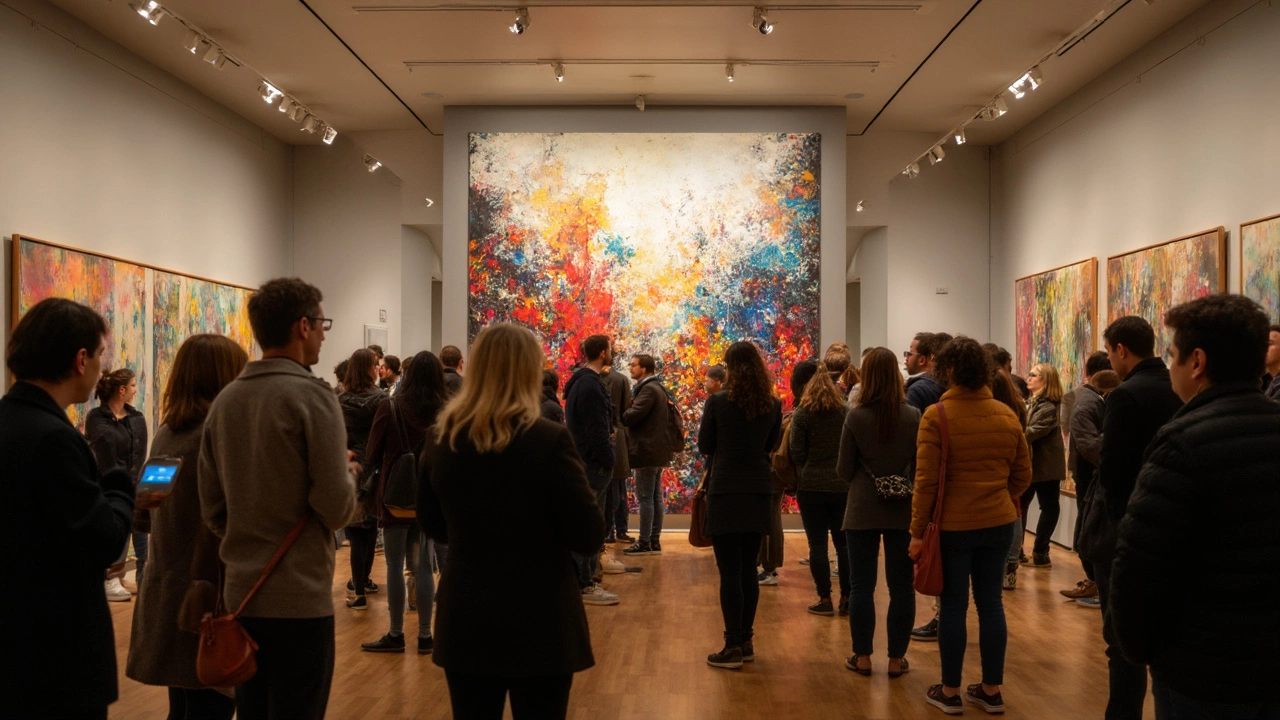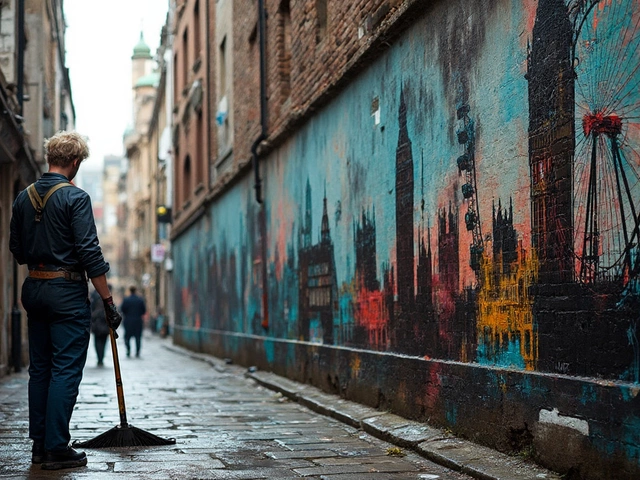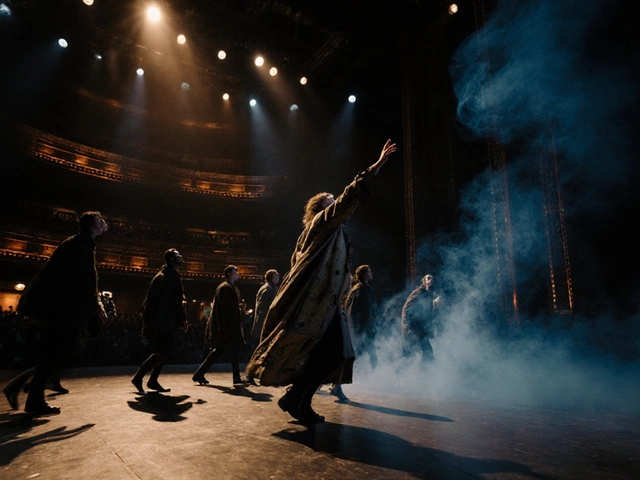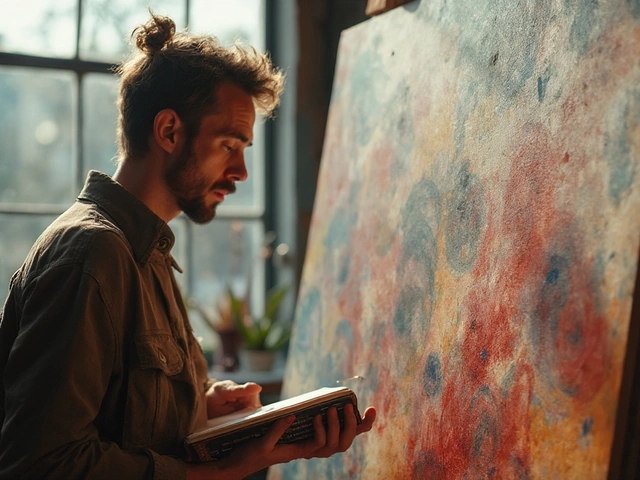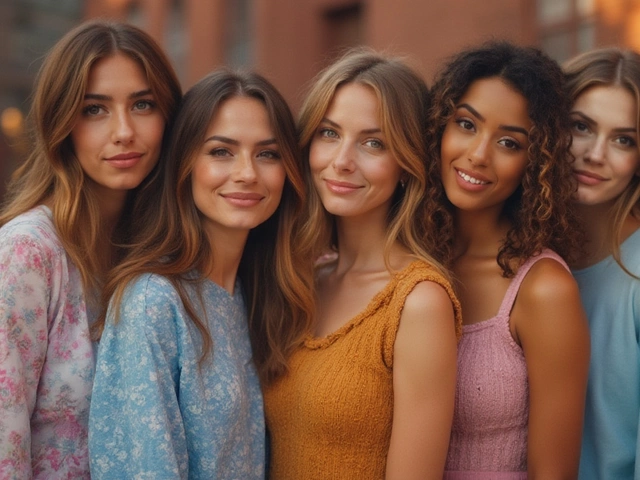Modern art really grabs our attention, doesn’t it? It’s everywhere—from gallery walls to street corners. But ever wonder why we are so fascinated by it? Unlike classical art, which often follows certain rules and conventions, modern art is all about breaking boundaries.
Take a stroll through a modern art gallery, and you’ll see what I mean. The sheer diversity and creativity are mind-blowing. Modern art invites you to look deeper and think harder about what you see. It doesn’t spoon-feed you a message; rather, it asks, 'What do you see?' This makes the experience personal and engaging.
Plus, modern art isn't just about what’s in the frame or sculpture. It's about how it makes you feel and what it makes you think about. It sparks emotions and discussions, making it an active part of our lives. Whether you love it or hate it, modern art makes sure you won’t ignore it. And let's not forget, it’s a great conversation starter too! Ever found yourself discussing an abstract painting and getting lost in its colors and forms?
- The Appeal of Innovation
- Breaking Traditions
- Personal Interpretations
- Emotional Connections
- Impact on Society
- Collecting Modern Art
The Appeal of Innovation
What makes modern art stand out? It's all about innovation. Unlike classical art, where the rules were set in stone, modern art loves shaking things up. Artists aren't afraid to experiment with new materials or tackle taboo subjects. They play with bright colors, abstract forms, and unconventional tools that turn heads and leave lasting impressions.
Think about artists like Jackson Pollock, who turned the art world upside down with his drip paintings. Or how about Yayoi Kusama's mind-bending installations? These artists challenge norms and get us to look at art—and maybe life—from new angles.
Did you know that some folks credit the technology boom with inspiring modern art's evolution? The invention of photography, for instance, pushed painters to explore more abstract concepts since cameras were capturing realism. It's an exciting cycle of innovation: new tech inspires new art, and new art pushes the boundaries of tech in return.
Embracing the New
Art lovers find this constant evolution thrilling. Modern art isn’t static; it’s an open dialogue inviting us to join in. The art itself often reflects society’s changes, making it relevant and relatable. It's as if every piece is a snapshot of a specific moment and mindset.
So, next time you walk into a modern art museum or scroll through an online gallery, look for the innovation—the boldness to do something different. It's not just a brush stroke or a splash of color; it's an invitation to think differently, too.
Breaking Traditions
When it comes to modern art, one of its most exciting aspects is how it dares to break away from the conventions of the past. Instead of sticking to the realism and precision of classical art, modern art often prioritizes creativity and expression over strict rules. This shift wasn't just artistic; it was downright revolutionary.
The Birth of New Styles
Think back to the early 20th century when artists like Picasso and Kandinsky decided to throw the rule book out the window. They introduced styles like Cubism and Abstract Art, which were all about seeing the world from a new perspective. No longer did a painting have to look like a photograph; it could be anything the artist imagined. This kind of freedom was unheard of, and it opened doors to an endless array of styles we've come to know as modern art.
Questioning Reality
What’s more, modern art often questions reality itself. Surrealism, for instance, aimed to unlock the imagination, capturing dreams and the unconscious mind on canvas. Artists such as Salvador Dalí played with bizarre and fantastical scenes that left viewers questioning both art and their own perception of reality. It’s this willingness to delve into the irrational that makes modern art so intriguing.
Embracing Change
The world was changing rapidly, with new technologies and ideologies emerging. Modern artists embraced these changes wholeheartedly, reflecting them in their work. Art became a way to comment on social issues, political upheavals, and technological advancements. Modern artists weren't just painters and sculptors; they were also social commentators, capturing the spirit of their times.
A great example is the pop art movement of the 1960s, which used imagery from commercial culture—like advertisements and comic strips—to challenge the traditional distinctions between high art and popular culture. Artists like Andy Warhol and Roy Lichtenstein turned everyday objects into art, making a statement about consumerism and mass production.
| Artist | Movement |
|---|---|
| Pablo Picasso | Cubism |
| Salvador Dalí | Surrealism |
| Andy Warhol | Pop Art |
All these changes stepped away from the past norms and truly redefined what art could be. It's no wonder that modern art continues to captivate and inspire, challenging us to see the world—or at the very least, the art on the walls—in a new light.
Personal Interpretations
One major allure of modern art is that it leaves so much room for personal interpretation. You can walk into a gallery and see two people completely disagreeing over what a piece represents. This is exactly what makes modern art so engaging.
Why Personal Interpretation Matters
Unlike traditional art that often depicts realistic scenes or religious themes with clear messages, modern art embraces ambiguity. An abstract painting might seem like just a splash of color to one person, while another might see a reflection of human struggle. The beauty of modern art lies in this open-endedness, inviting viewers to project their own experiences and feelings onto the artwork.
The Connection to Emotion
Modern art has a unique way of striking an emotional chord. As viewers interpret an art piece through their personal lens, it often connects to their life stories and current experiences. This is why one person might feel joy while another feels discomfort when looking at the same artwork. By engaging our emotions, modern art encourages us to not only appreciate what we see but also to reflect on our personal journey.
Examples of Personal Interpretations
Taking Jackson Pollock’s drip paintings as an example, some viewers find chaos and disorder, while others see patterns and deliberate choices. This varying personal interpretation fuels continuing discussions and keeps the audience engaged over time. Andy Warhol’s work, too, prompts discussions about consumer culture which some see as critical and others as celebratory.
Building Community Through Discussion
What’s interesting is how these art preferences and interpretations often lead to lively debates and discussions, both in galleries and online. They foster a sense of community among art lovers and casual viewers alike. Sharing different views on the same piece enriches the experience and broadens our understanding of both the art and each other.
In essence, the personal interpretation allowed by modern art not only makes it deeply personal but also incredibly communal. It grows beyond just an individual's experience to become a shared conversation, a collective way to explore and understand the world around us.
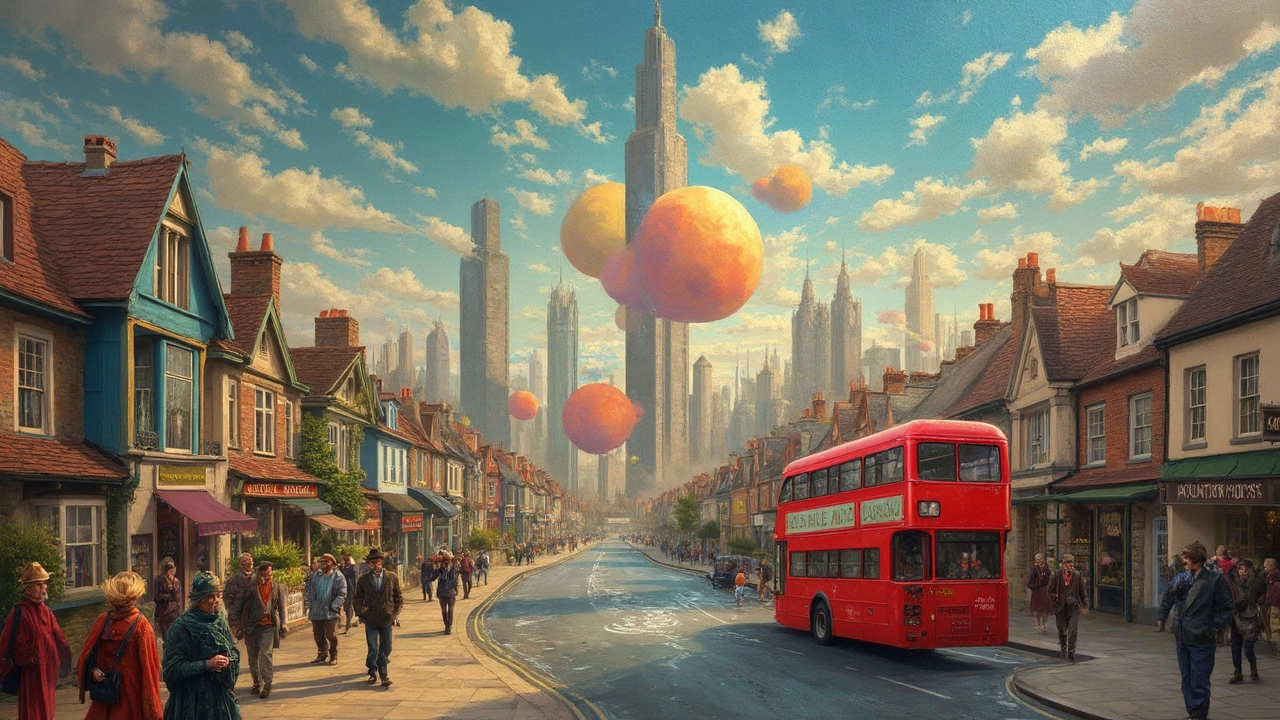
Emotional Connections
Have you ever stood in front of a piece of modern art and felt something deep inside, even if you couldn't quite put it into words? That's the power of emotional connection at work. Modern art has a unique ability to tap into our feelings and evoke reactions that are both unexpected and profound.
One reason for this strong emotional pull is the freedom artists have when creating modern artworks. Freed from the constraints of traditional art forms, artists explore varied emotional landscapes, from joy and serenity to chaos and confusion. This diversity in expression means there’s a piece of modern art that can resonate with just about everyone.
Relatability Through Abstraction
Unlike its more classical counterparts, modern art often relies on abstraction, which means it doesn’t always give a clear subject or theme. This invites viewers to project their own experiences and emotions onto the artwork. In fact, a study from the Tate Group highlights that many patrons find personal stories within abstract art that relate to their own lives, making the artwork profoundly meaningful on a personal level.
Color and Emotion
Color plays a big role in the emotional impact of modern art. Bold, contrasting colors can evoke excitement or tension, while softer, harmonious palettes might bring about feelings of calm and introspection. Psychologist Eva Heller analyzed how colors influence emotions, revealing that color preferences can directly affect how we relate to and perceive a piece of art.
Art as a Mirror
Modern artworks serve as mirrors to society and personal lives. Artists tackle themes like consumerism, identity, and technology, allowing viewers to reflect on wider issues they face in everyday life. This reflection can be cathartic, providing comfort or even empowerment as viewers see their struggles and triumphs mirrored in an artist’s work.
Next time you're in a gallery, take a moment to really experience the art. Let your feelings guide your interpretation, and you might find a deeper connection than you expected. Art appreciation is as much about intuition and emotion as it is about understanding techniques and history.
Impact on Society
Modern art's influence stretches way beyond the realm of galleries and exhibitions. It's like a mirror reflecting societal changes and, at times, even shaping them. One of the big reasons modern art is so impactful is because it challenges the norms, encouraging people to think differently and question what's 'normal'.
The Cultural Revolution
Think about the cultural shifts of the 20th century—movements like pop art were more than just about art; they turned into symbols of a broader social revolution. Modern art reflects these societal moods and shifts, bringing them into the mainstream conversation. And it's fascinating how something as abstract as a painting or installation can inspire concrete change in society.
Art as a Platform for Dialogue
Modern art has the unique ability to start big conversations about important issues. It gives voice to underrepresented communities, raising awareness about social injustices. As Pablo Picasso famously said,
“The purpose of art is to wash the dust of daily life off our souls.”Through art, marginalized voices find a platform to express stories that might otherwise go unheard.
Economic Contributions
Besides the cultural and social angles, modern art plays a big part in the economy too. Auction houses like Sotheby’s have shown modern art pieces fetching higher prices than ever, and global art fairs are booming. This kind of activity not only boosts the art market but also fuels tourist economies around major art events worldwide.
| Year | Estimated Global Art Market Value (in billion USD) |
|---|---|
| 2020 | 50 |
| 2023 | 65 |
So, whether it's encouraging open thinking, giving a voice to the voiceless, or contributing to a country's GDP, modern art's impact on society is massive, making it all the more relevant in today's world.
Collecting Modern Art
Hey, thinking about collecting modern art? It's a thrilling venture, full of surprises. Modern and contemporary art pieces are not just beautiful—they’re a great investment too. The art market has seen a significant rise with works reaching record prices at auctions, making it a wise choice for both personal enjoyment and financial gains.
Before you dive in, it’s wise to do some homework. Start by visiting galleries, museums, and art fairs. Engage with curators and collectors. They offer insights that are gold for prospective collectors. Don’t hesitate to ask questions—it’s the best way to learn what you’re truly passionate about. Better yet, learn what styles or artists resonate with you personally.
What to Consider
When collecting, look beyond the frame. Consider the movement an artwork represents, its impact on society, and underlying ideals. Are you into abstract expressionism, pop art, or perhaps something more avant-garde?
- Budget: Establish a budget. While you can find pieces ranging from a few hundred to several million dollars, setting a budget helps streamline options.
- Authenticity: Always ensure the artwork's authenticity. Work with reputable dealers and galleries to avoid counterfeits—a certified piece will hold its value better.
- Condition: The piece’s condition is crucial. Even minor damage can affect its market value.
- Insurance: Once you own a piece, make sure it's insured. Art insurance protects against damage, theft, and loss.
Getting Started
Explore online platforms like Artsy or Saatchi Art, which have made it easier than ever to access modern art from anywhere. If you’re within proximity, auction houses like Sotheby’s or Christie’s have regular events—attending these can be quite an eye-opener.
Collecting modern art isn't just about the destination—it’s the journey too. Each piece has a story, be it through its colors, materials, or techniques. So enjoy the ride, discover new artists, and maybe hang a future masterpiece on your wall.
| Year | Total Industry Sales (in billions) | Modern Art Share |
|---|---|---|
| 2020 | 50 | 37% |
| 2023 | 68 | 43% |
Embrace this fascinating world. With each artwork, you're not just a buyer—you're a custodian of culture and creativity.
